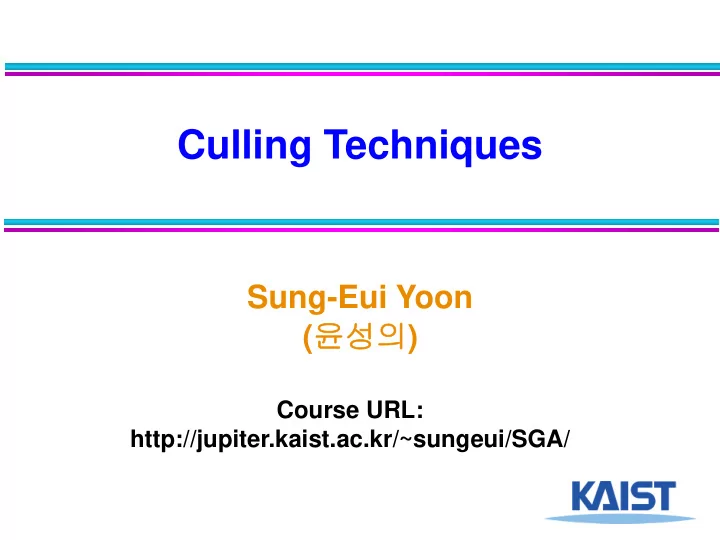

Culling Techniques Sung-Eui Yoon ( 윤성의 ) Course URL: http://jupiter.kaist.ac.kr/~sungeui/SGA/
At the Previous Class ● The overview of the course ● Two main rendering techniques: rasterization and ray tracing ● Their issues with different configurations 2
Rasterization: Rendering Pipeline Per- Frame Host Vertex Cull, Clip Fragment Fragment Buffer Process Commands Transforms & Project Processing Operations Operations And Rasterize Primitive Texture Frame Memory Buffer Display 3
Depth Buffer Algorithm: Maintain current closest surface at each pixel Rendering Loop: set depth of all pixels to Z MAX foreach primitive in scene foreach pixel in primitive compute z prim at pixel if (z prim < depth pixel ) then pixel = object color depth pixel = z prim endif endfor endfor 4
Depth Buffer: Advantage ● Simple ● Can process one primitive at a time in any order ● Can easily composite one image/ depth with another image/ depth ● Useful for parallel rendering especially for sort-last based method ● Spatial coherence ● I ncremental evaluation in loops ● Good memory coherence 5
Depth Buffer: Disadvantage ● Transparency is hard to handle ● Has to be done in strict back-to-front order ● Lots of overdraw ● Read/ Modify/ Write is hard to make fast ● Requires a lot of storage ● Quantization artifacts 6
Limitations of Rasterization ● The performance ~ linear to # of triangles ● Massive models with high-depth or low- depth complexity ● Require output sensitive rendering methods ● Culling techniques for high-depth complexity ● Multi-resolution techniques for low-depth complexity 7
What are Culling and Clipping? ● Culling ● Throws away entire objects and primitives that cannot possibly be visible ● Clipping ● “Clips off” the visible portion of a primitive ● Simplifies rasterization ● Used to create “cut-away” views of a model 8
Visibility Culling Methods ● Back-face culling ● View frustum culling ● Occlusion culling ● Hierarchical culling 9
Culling Example ● Power plant model ● 13 M triangles ● 1.7 M triangles - gutted version show here with no internal pipes 10
Culling Example Full model View frustum culling Occulsion culling 1.7 Mtris 1.4 Mtris 89 Ktris 11
Back-Face Culling ● Special case of occlusion - convex self- occlusion ● for closed objects (has well-defined inside and outside) some parts of the surface must be blocked by other parts of the surface ● Specifically, the backside of the object is not visible 12
Face Plane Test v & ● Compute the plane for the face: 2 v v = − × − & n (v v ) (v v ) & & & & 1 1 0 2 0 v & = ⋅ d n v 0 v & 0 ● Cull if eye point in the negative half-space 13
Lines and Planes ● I mplicit equation for line (plane): ˆ n + − = n x n y d 0 x y ⎡ ⎤ x ⎢ ⎥ d − = ⇒ ⋅ = [ n n d] y 0 l p 0 & ⎢ ⎥ x y ⎢ ⎥ 1 ⎣ ⎦ (0,0) v ● I f is normalized then d gives the distance of the n v n line (plane) from the origin along 14
View Frustum Culling ● Test objects against planes defining view frustum ● Uses BVs of objects to improve the performance of view-frustum culling 15
Depth Complexity ● Number of triangles per each pixel ● Likely to grow as the model complexity increases 16
Occlusion Culling ● Detects visibility of primitives ● I f invisible, do not need to process such primitives ● What are ingredients for the success of the method? ● Fast visibility checking ● Conservative primitive enclosing with BVs, etc. 17
Hardware Accelerated Occlusion Query 18 Excerpted from NVIDIA slides
Excerpted from NVIDIA slides 19
Occlusion Culling with Occlusion Queries ● Render objects visible in previous frame (occlusion representation) 20
Occlusion Culling with Occlusion Queries ● Turn off color and depth writes ● Render object bounding boxes with occlusion queries newly visible 21
Occlusion Culling with Occlusion Queries ● Re-enable color writes ● Render newly visible objects 22
Assumptions & Limitations ● Assume temporal coherence ● How about the initial frame? ● Can we take advantage of spatial coherence between objects? 23
Hierarchical Culling ● Culling needs to be cheap! ● Bounding volume hierarchies accelerate culling by trivially rejecting/ accepting entire sub-trees at a time not visited Indeterminate visited Inside Indeterminate Inside Inside Indeterminate Outside Example of hierarchical view-frustum culling 24
Visibility Computations ● Fundamental question: ● Between which parts of a scene does there exist an unobstructed path? ● Types of visibility computations ● Hidden surface removal ● Visibility culling ● Some other related applications ● Line-of-sight ● Sound propagation ● Path planning and robotics 25
Classes of Visibility Algorithms ● Point vs. Region visibility ● Compute parts of the scene visible at a point or any point in a region ● Object vs. I mage precision ● Compute parts of an object (or which pixel) that are visible ● Operates directly on or discretized representation of the geometry 26
Ray Tracing: Visibility Issue ● For each pixel, find closest object along the ray and shade pixel accordingly ● Advantages ● Conceptually simple ● Can support CSG ● Can be extended to handle global illumination effects (ex: shadows and reflectance) ● Disadvantages ● Renderer must have access to entire retained model ● Hard to map to special-purpose hardware 27
Next Time.. ● Study culling techniques ● E.g., Multi-resolution methods 28
Recommend
More recommend